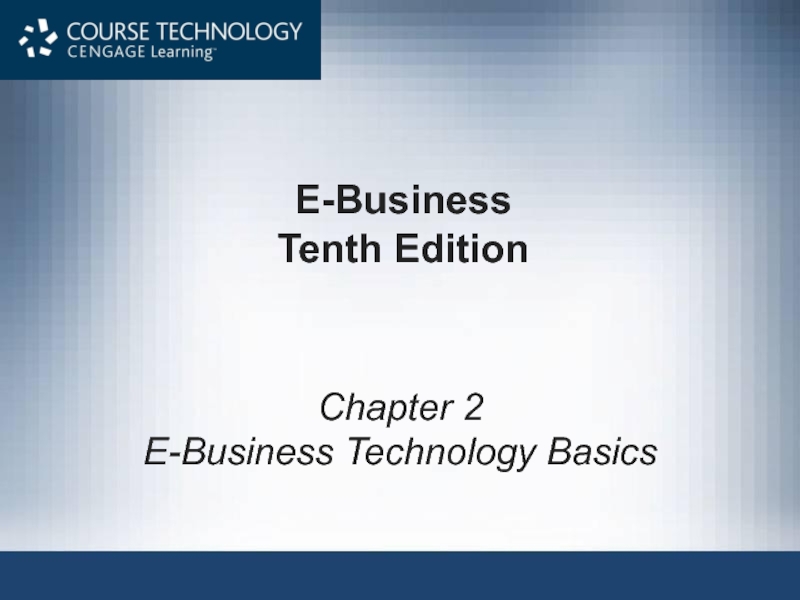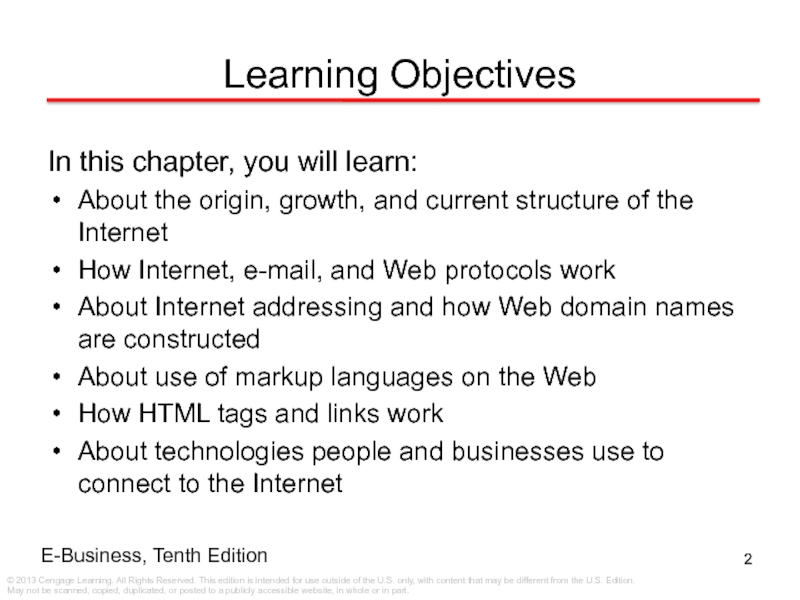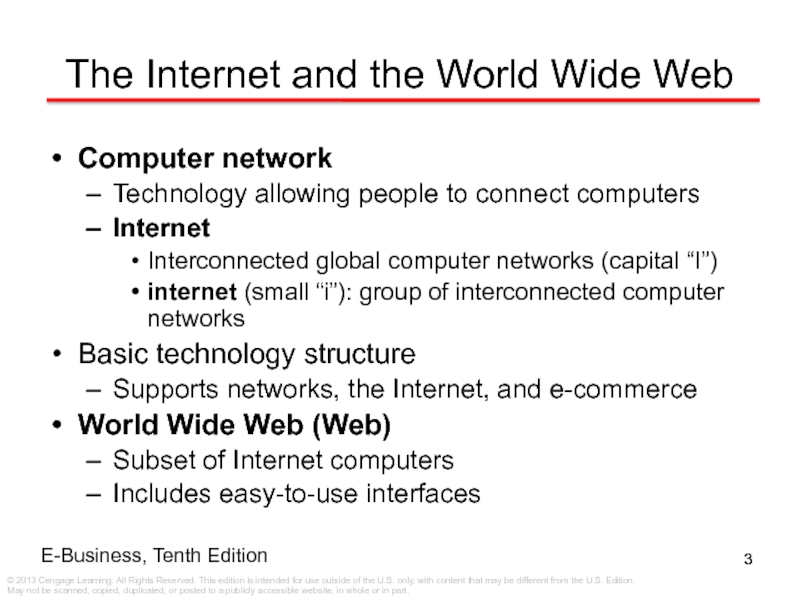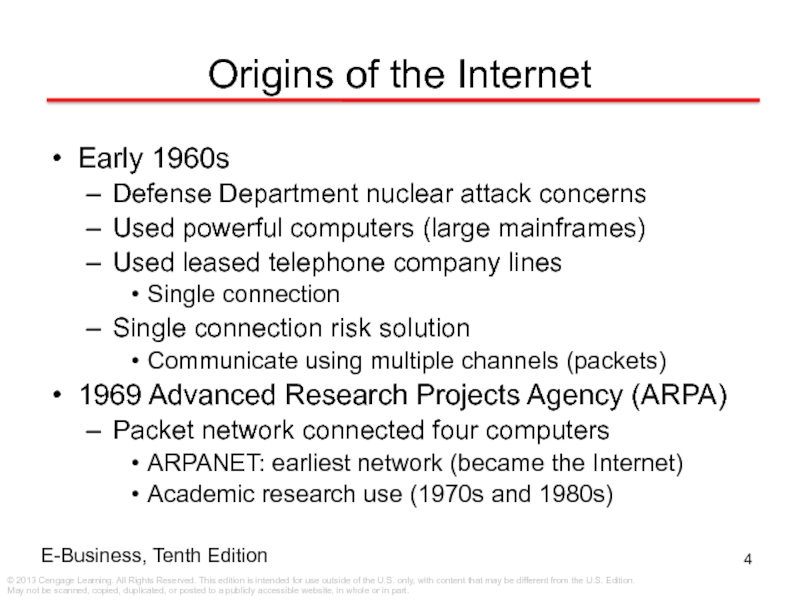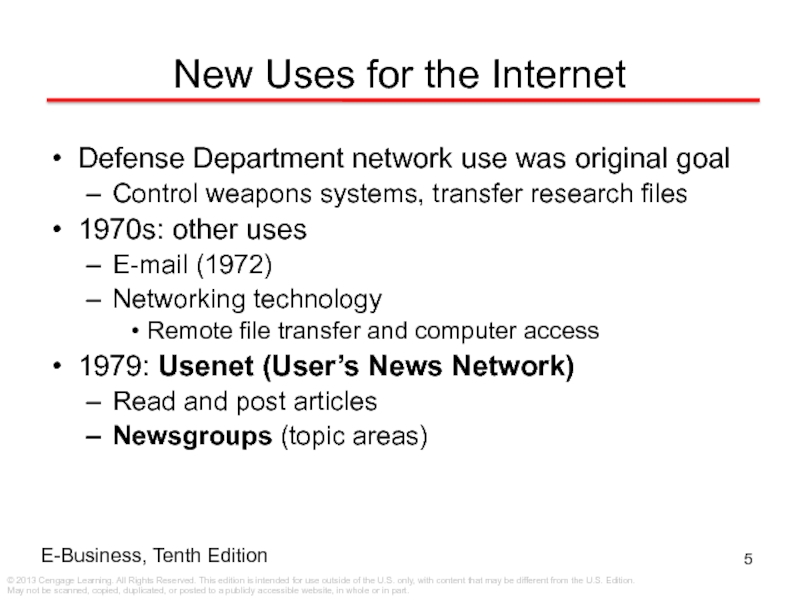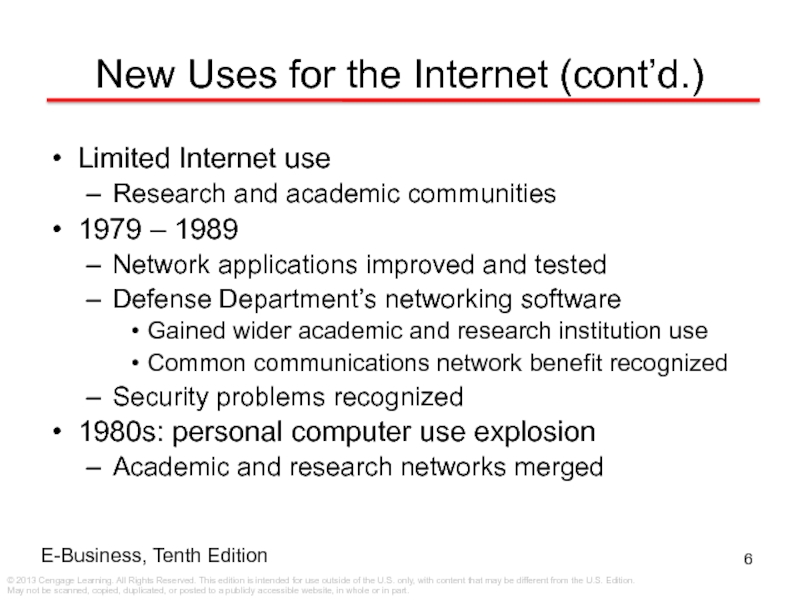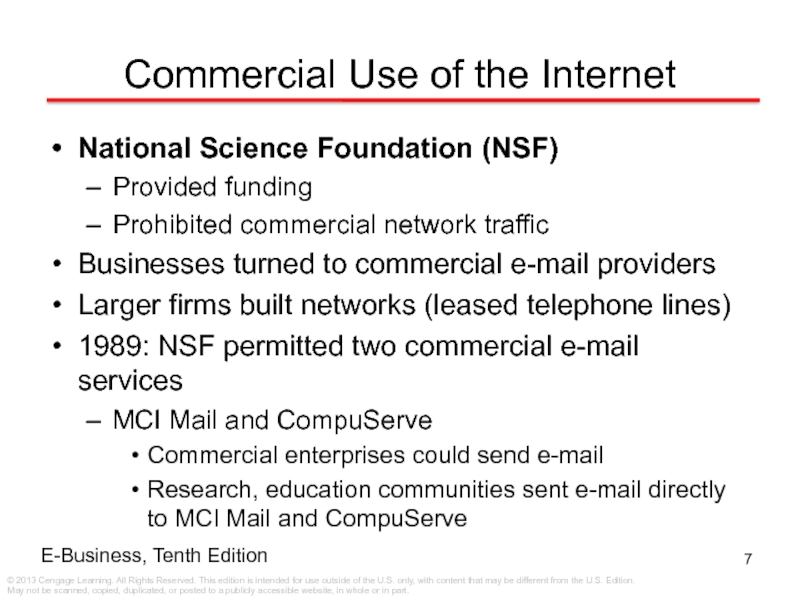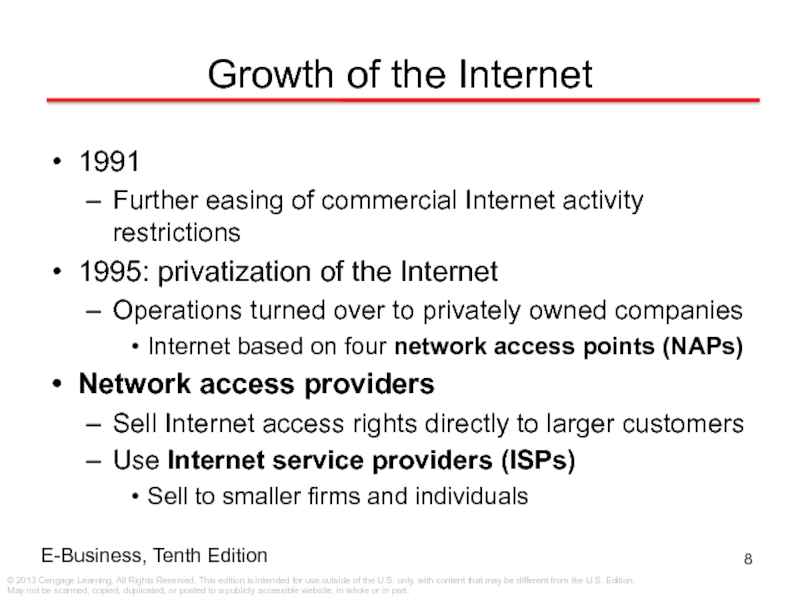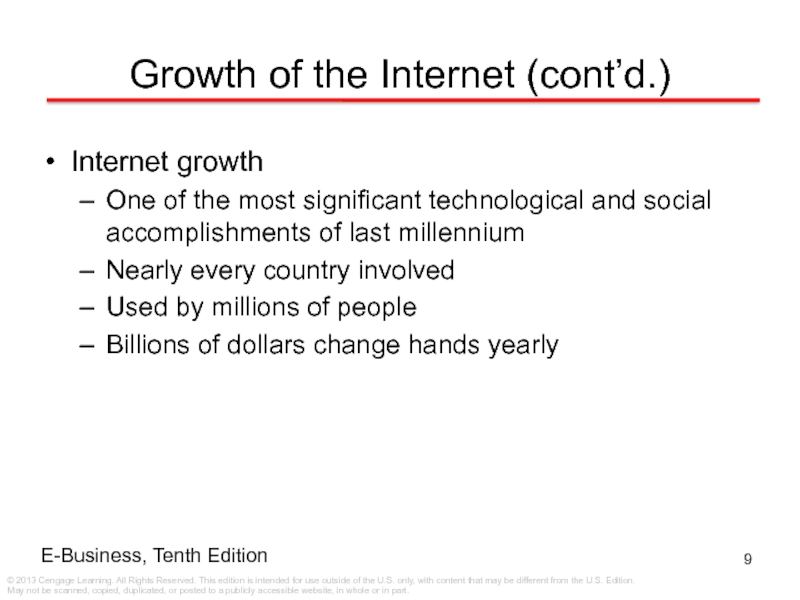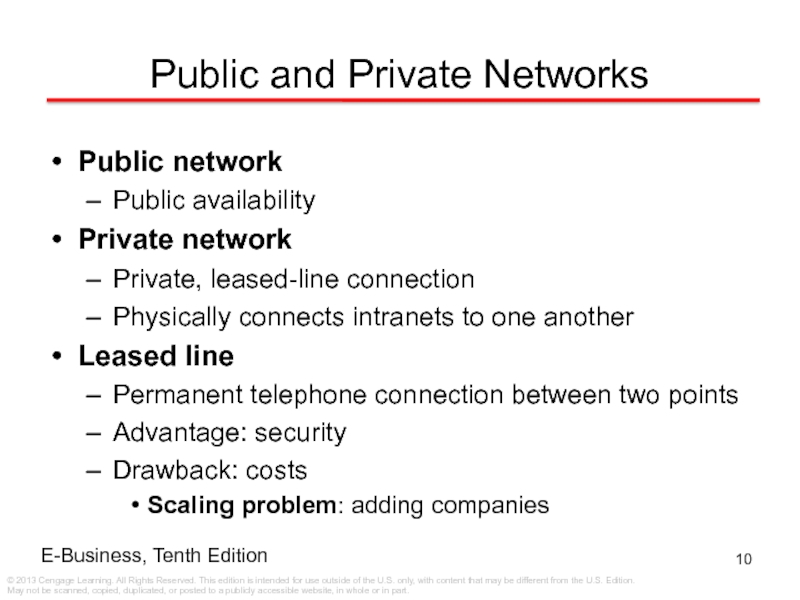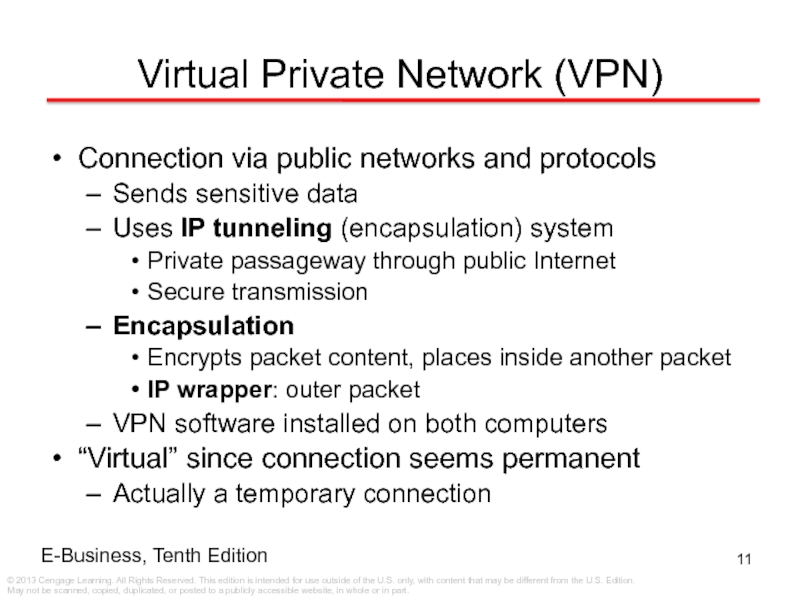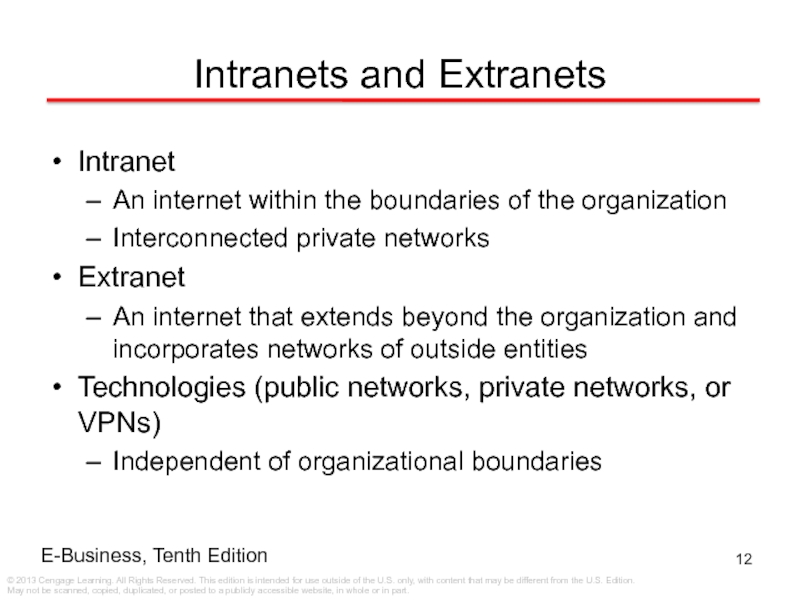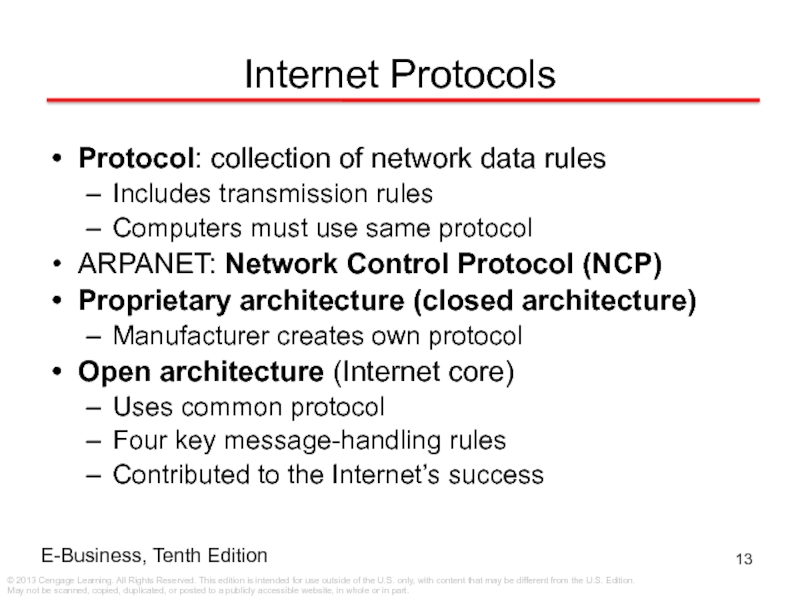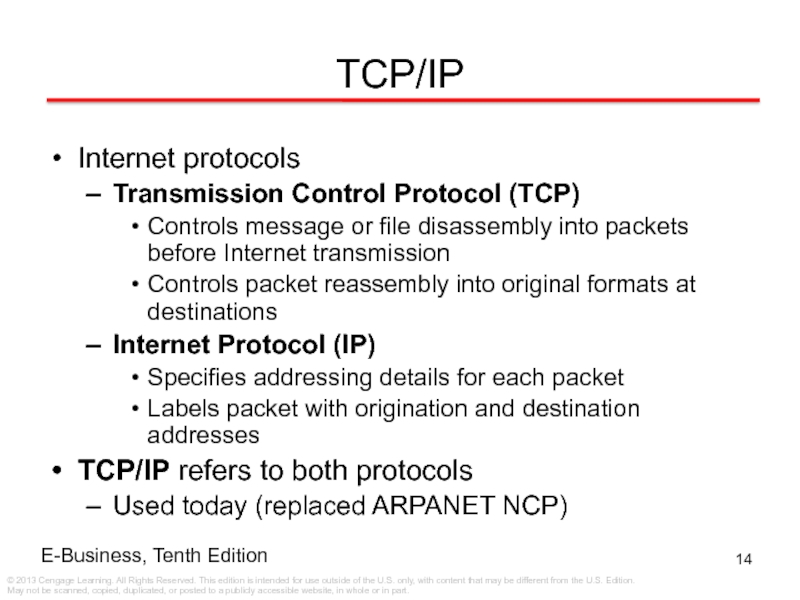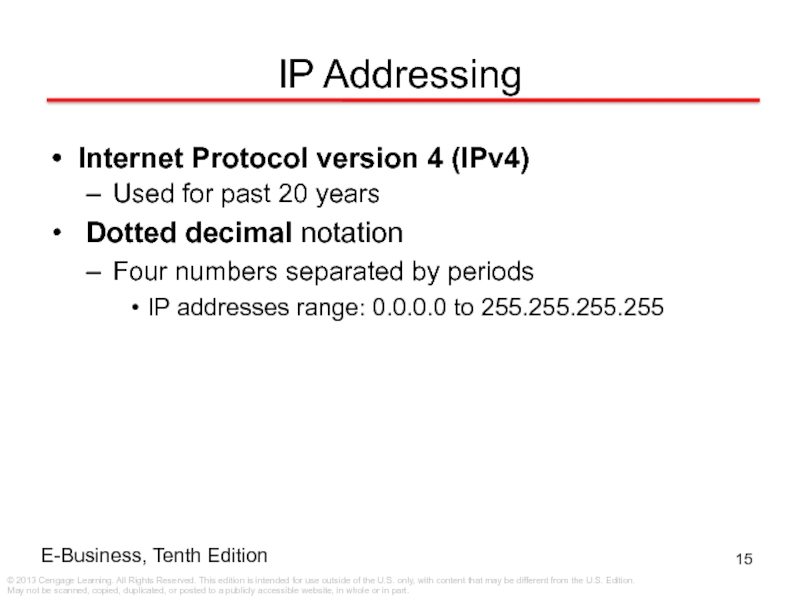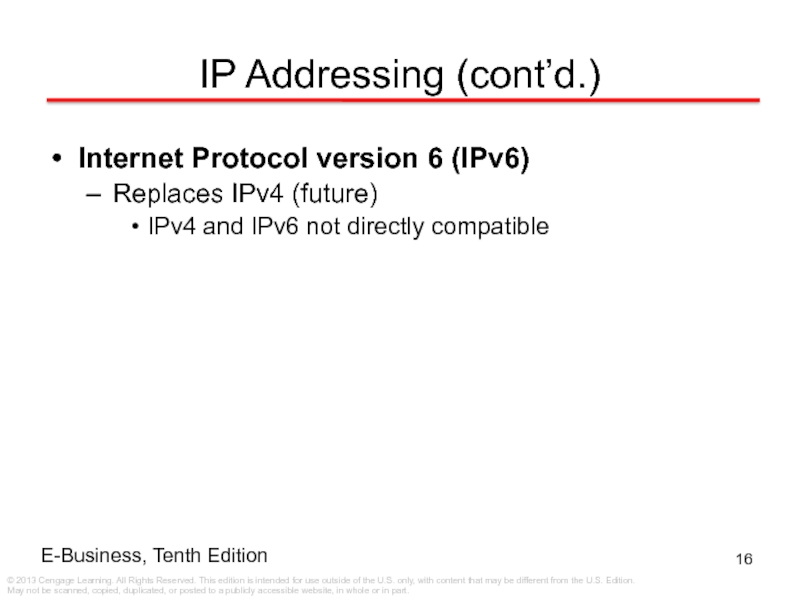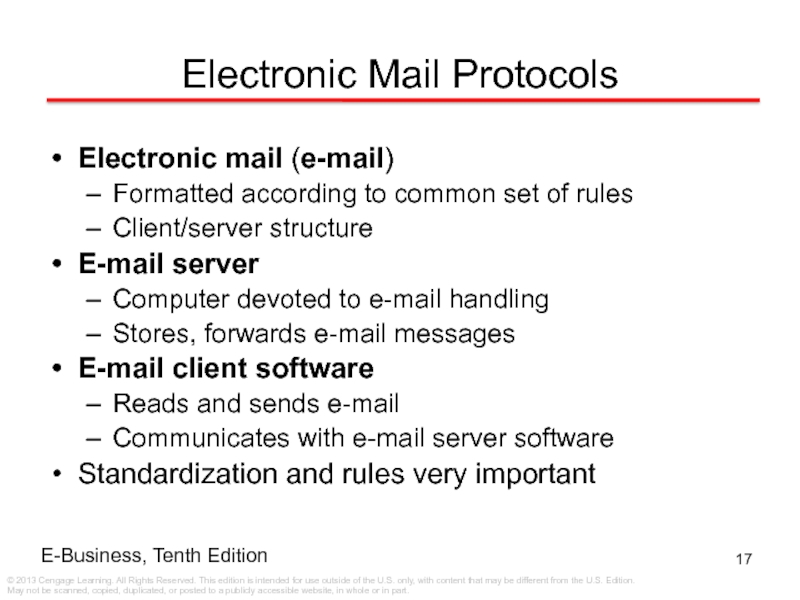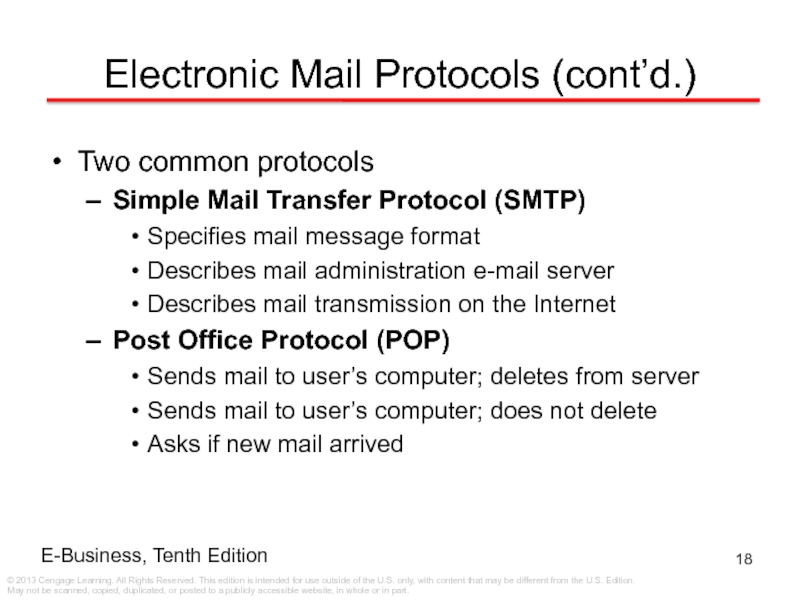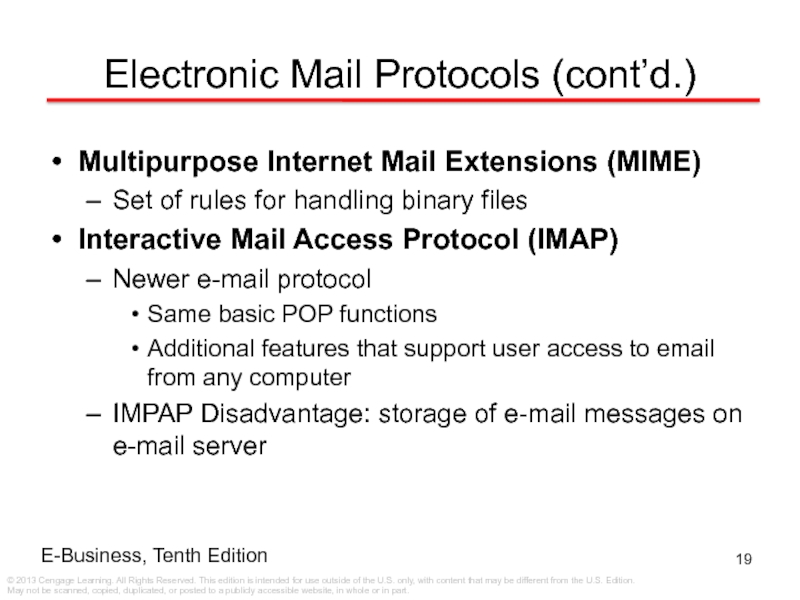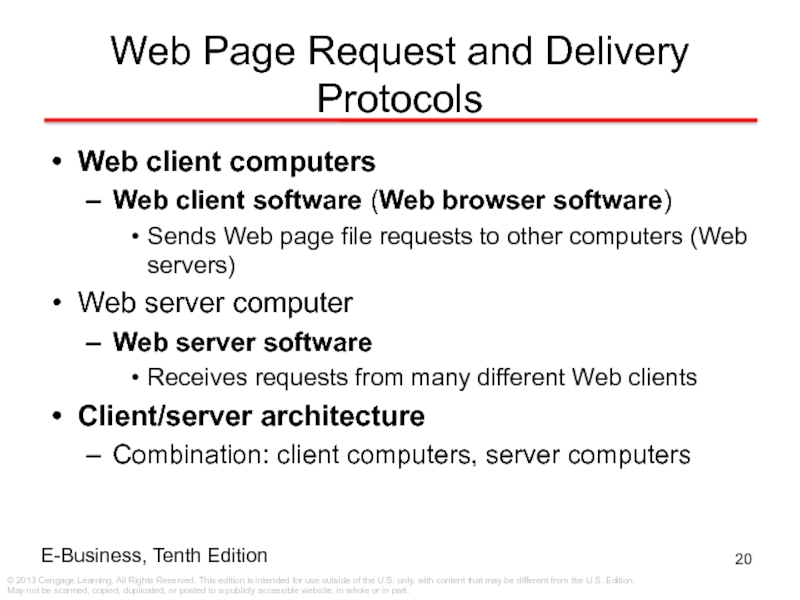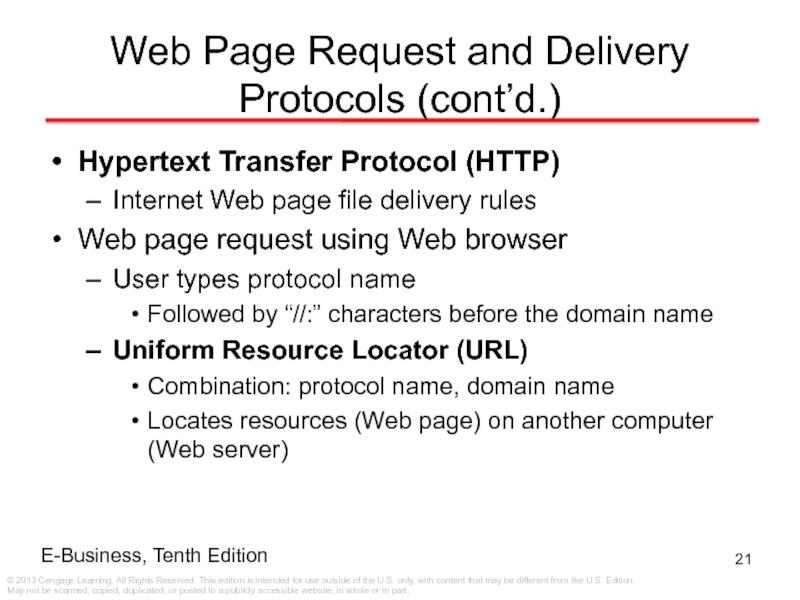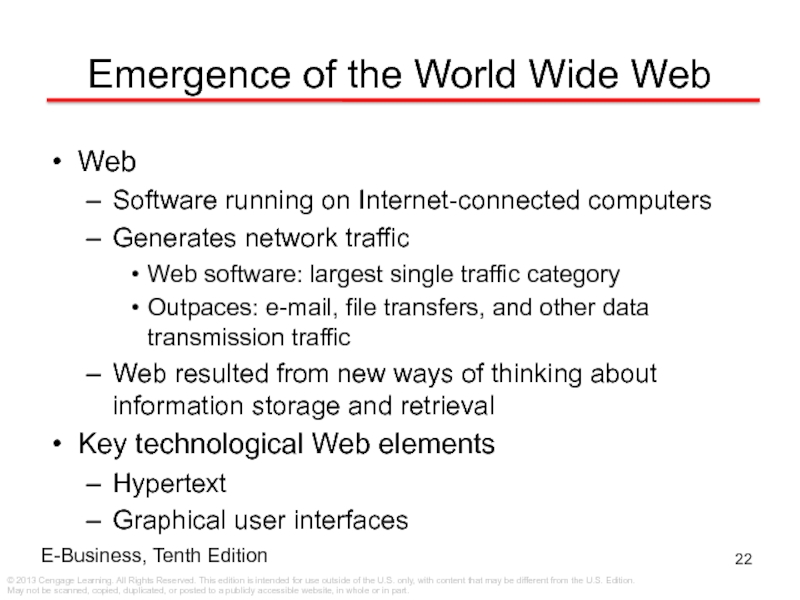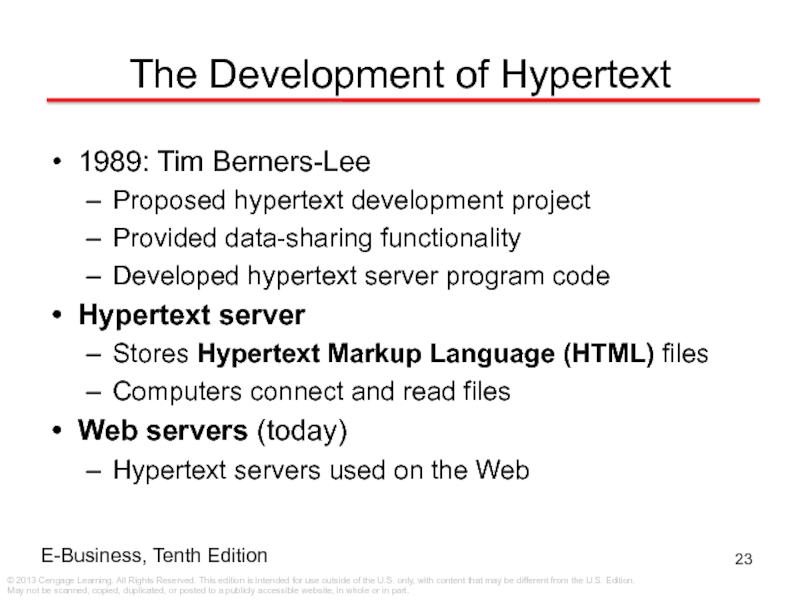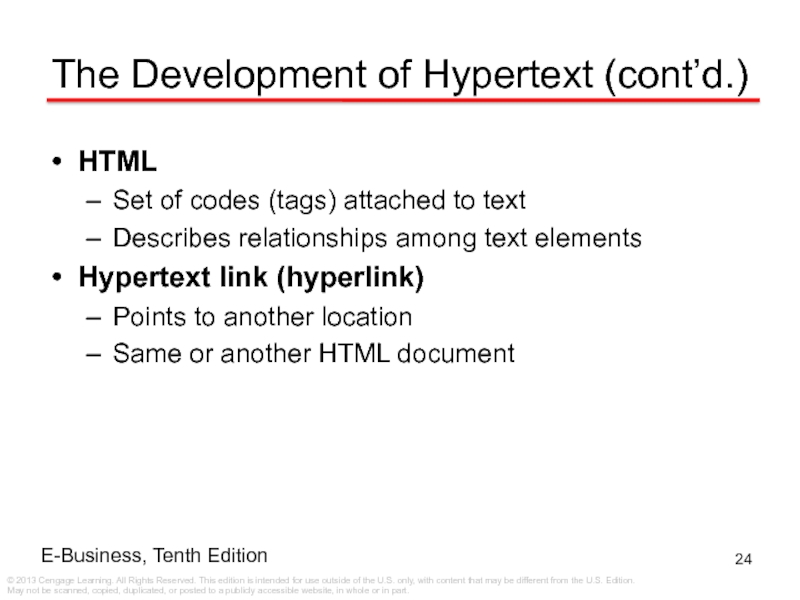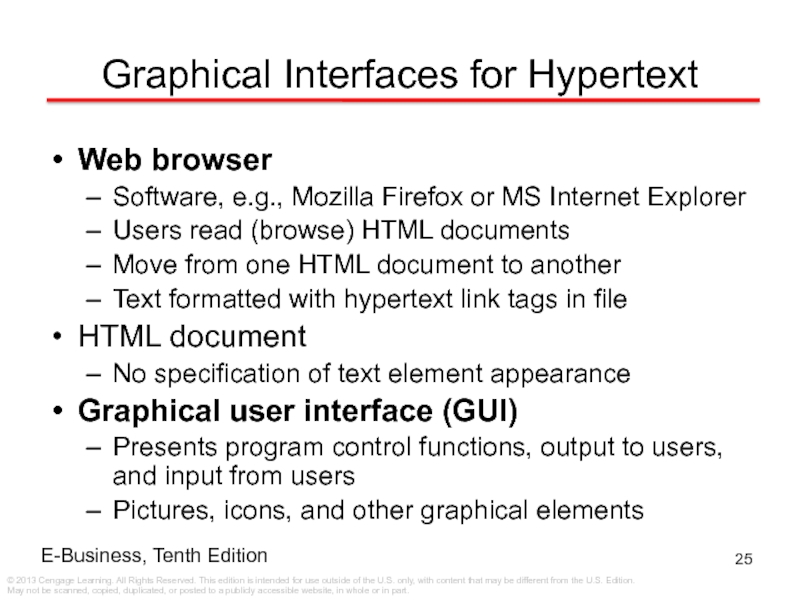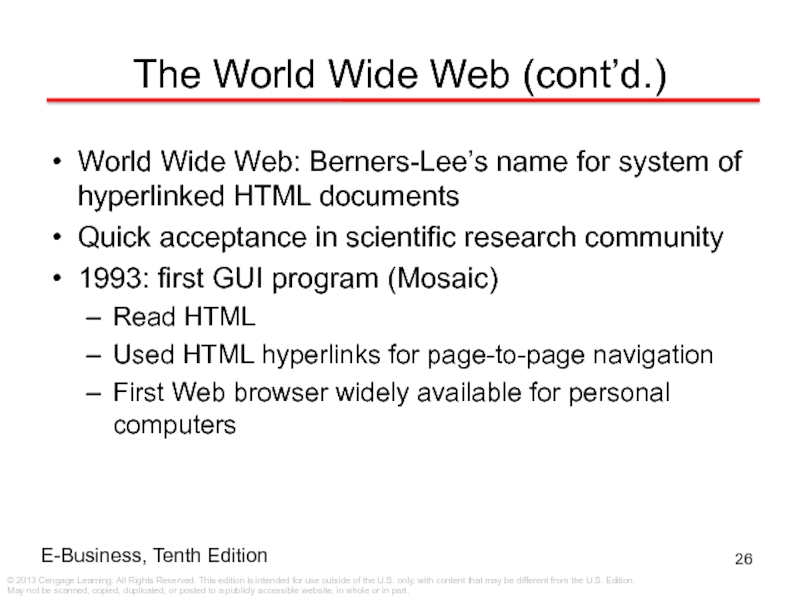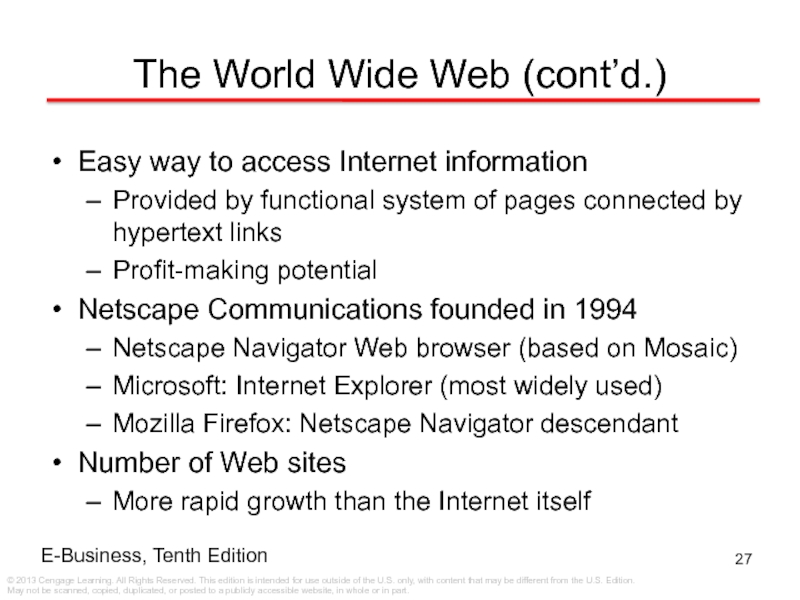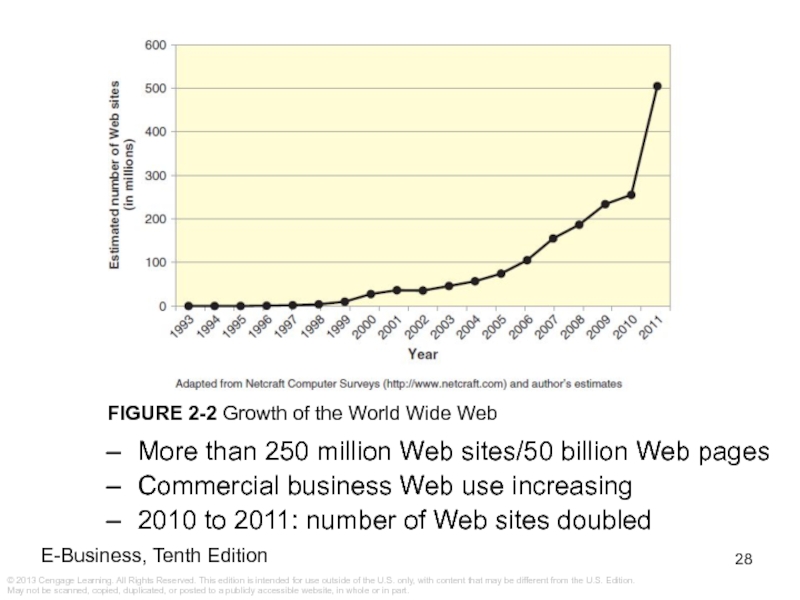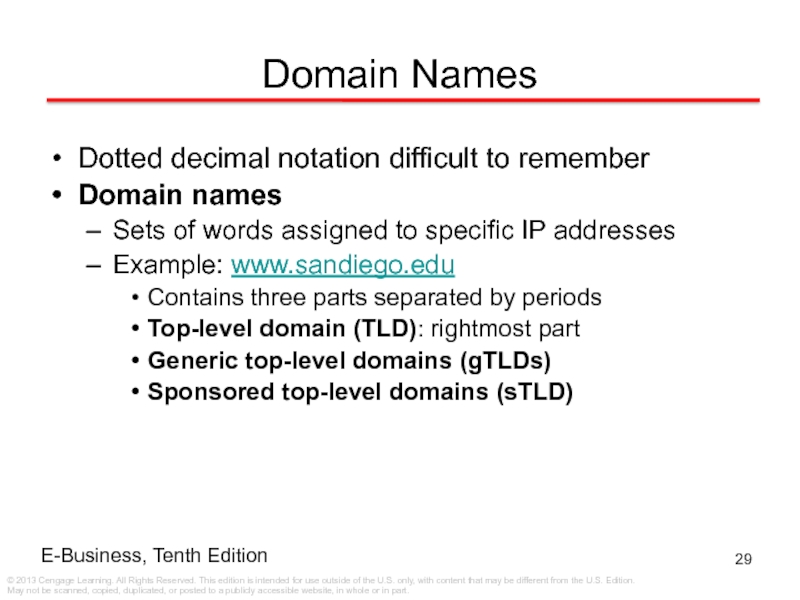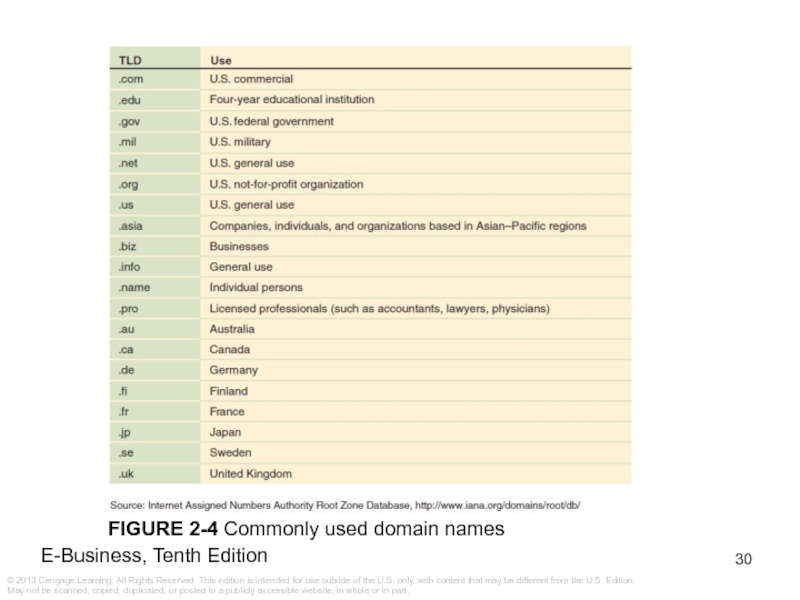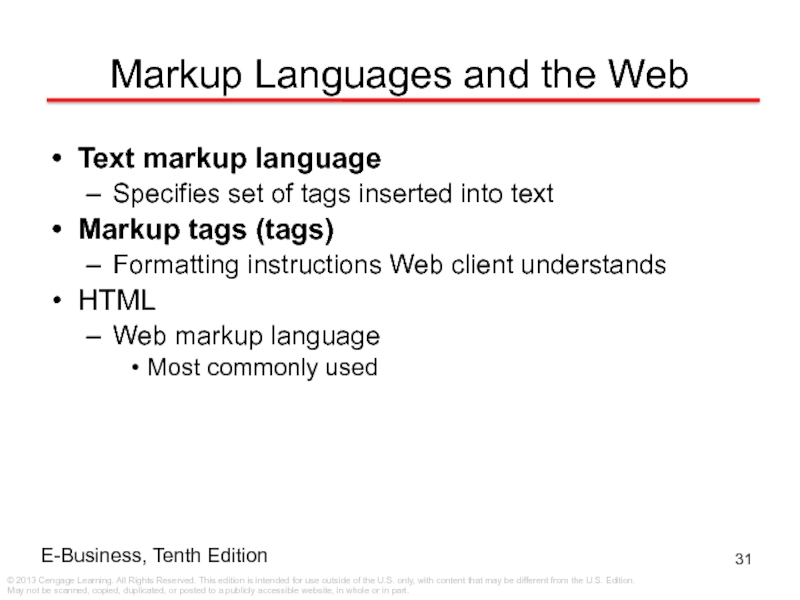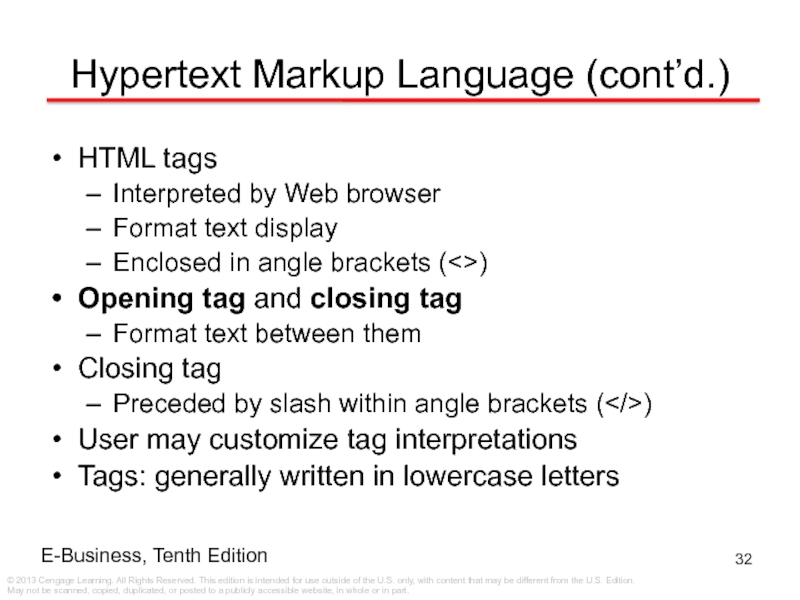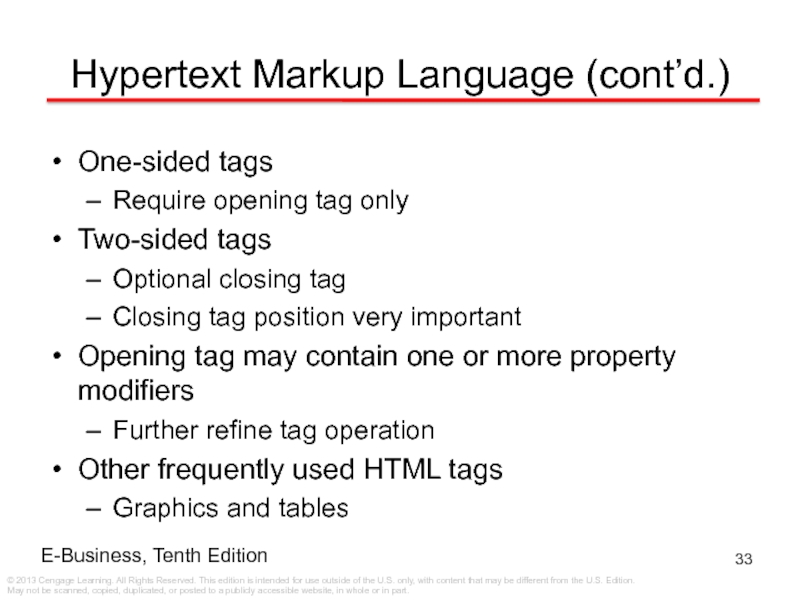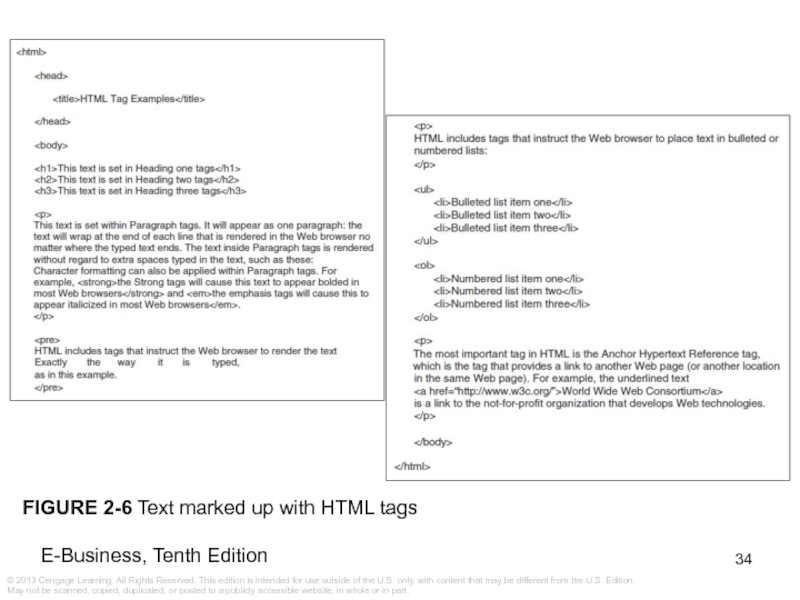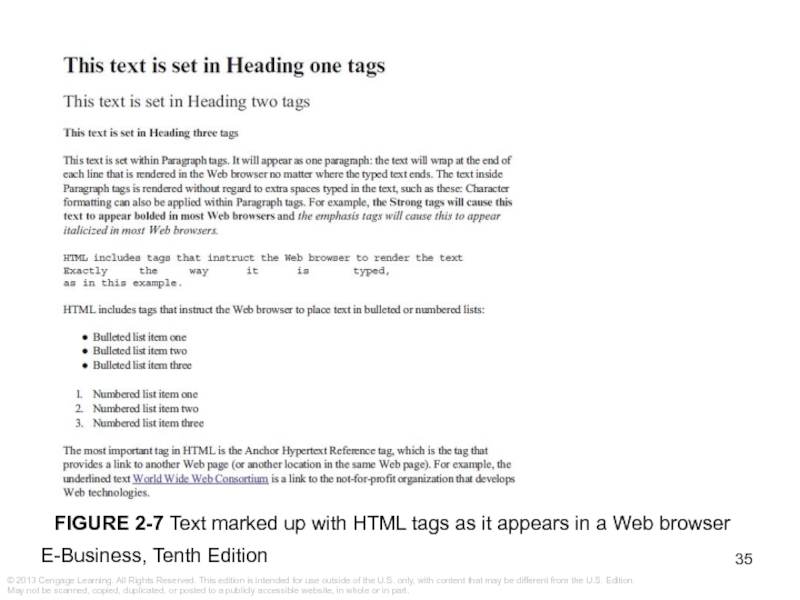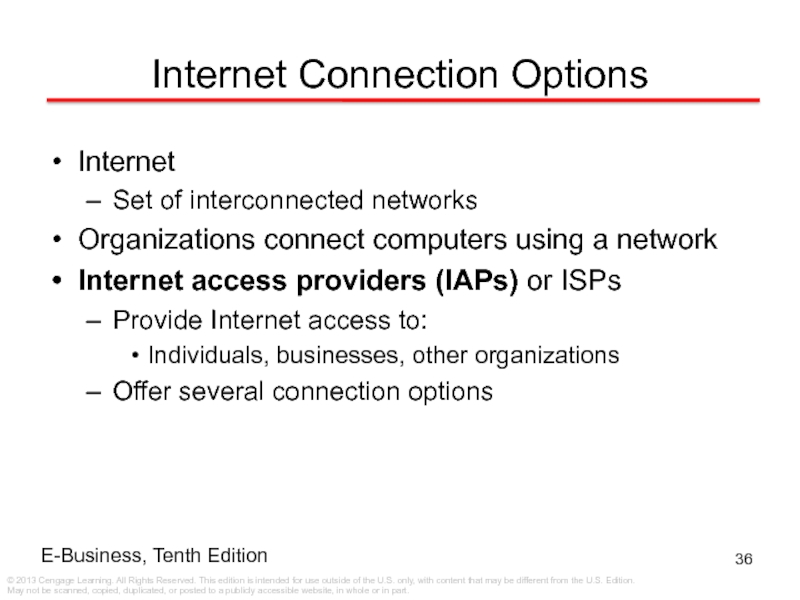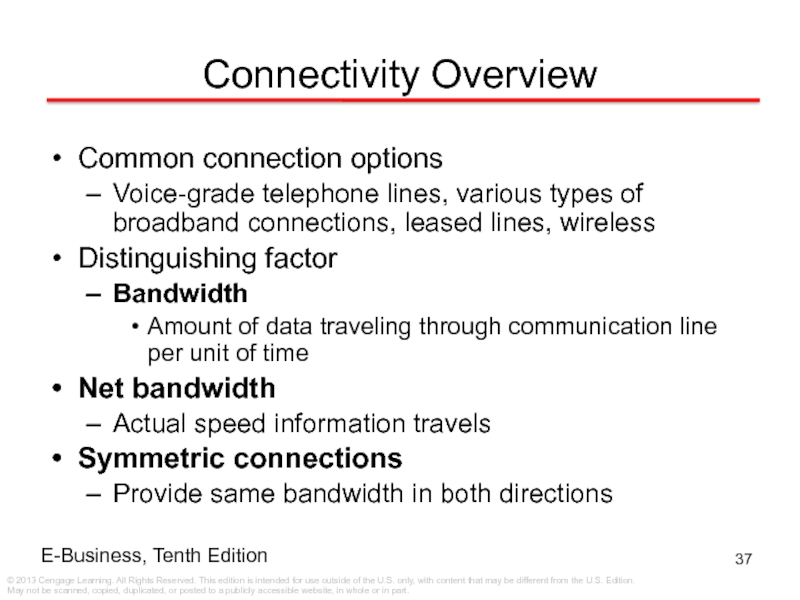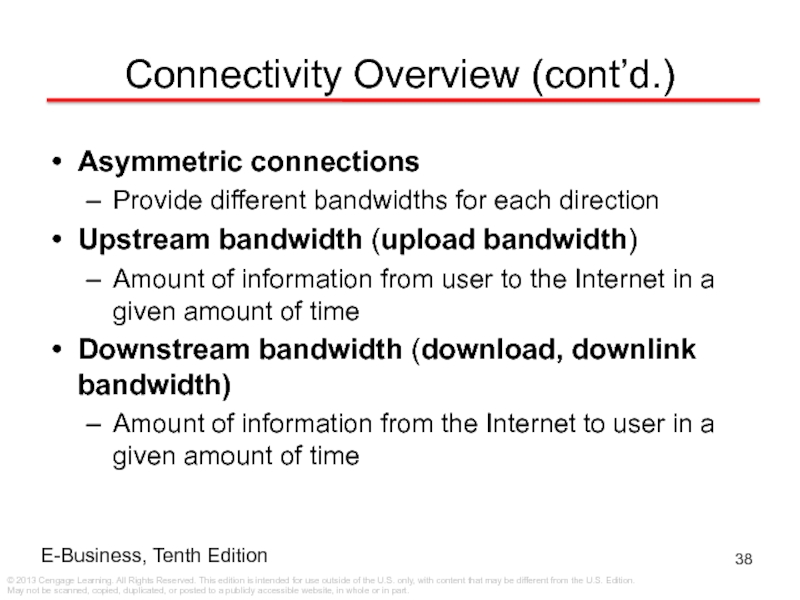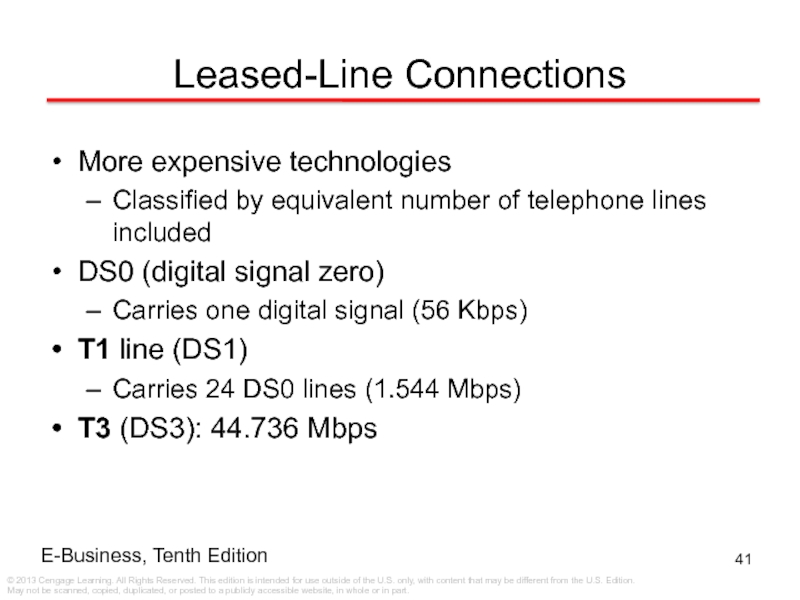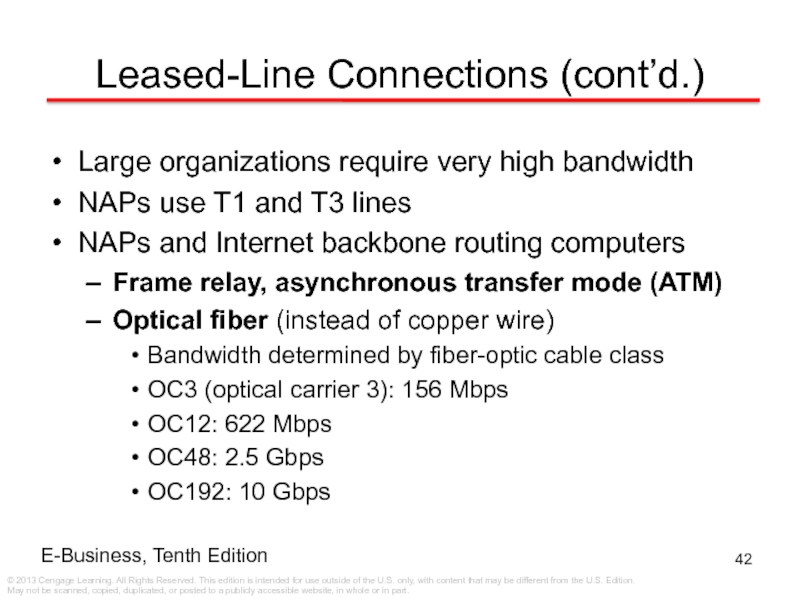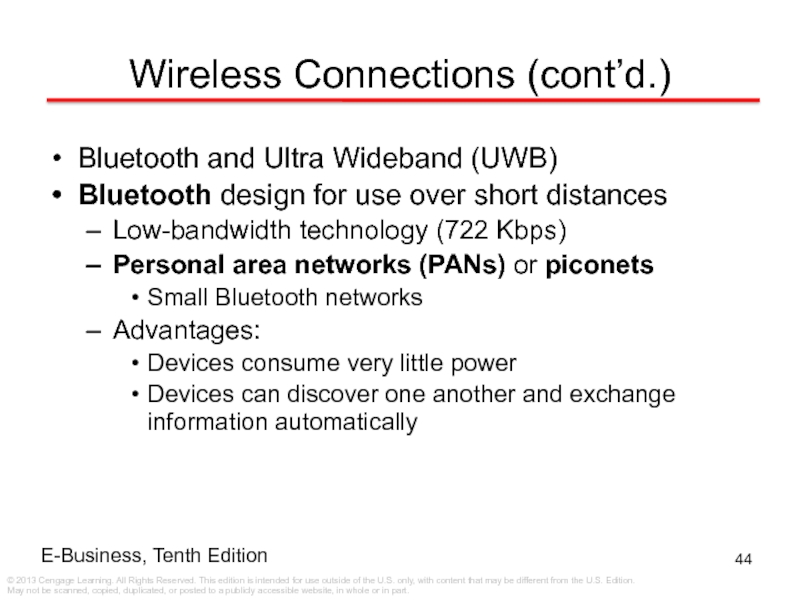Слайд 1E-Business
Tenth Edition
Chapter 2
E-Business Technology Basics
Слайд 2Learning Objectives
In this chapter, you will learn:
About the origin, growth,
and current structure of the Internet
How Internet, e-mail, and Web
protocols work
About Internet addressing and how Web domain names are constructed
About use of markup languages on the Web
How HTML tags and links work
About technologies people and businesses use to connect to the Internet
Слайд 3The Internet and the World Wide Web
Computer network
Technology allowing people
to connect computers
Internet
Interconnected global computer networks (capital “I”)
internet (small “i”):
group of interconnected computer networks
Basic technology structure
Supports networks, the Internet, and e-commerce
World Wide Web (Web)
Subset of Internet computers
Includes easy-to-use interfaces
Слайд 4Origins of the Internet
Early 1960s
Defense Department nuclear attack concerns
Used powerful
computers (large mainframes)
Used leased telephone company lines
Single connection
Single connection risk
solution
Communicate using multiple channels (packets)
1969 Advanced Research Projects Agency (ARPA)
Packet network connected four computers
ARPANET: earliest network (became the Internet)
Academic research use (1970s and 1980s)
Слайд 5New Uses for the Internet
Defense Department network use was original
goal
Control weapons systems, transfer research files
1970s: other uses
E-mail (1972)
Networking technology
Remote
file transfer and computer access
1979: Usenet (User’s News Network)
Read and post articles
Newsgroups (topic areas)
Слайд 6New Uses for the Internet (cont’d.)
Limited Internet use
Research and academic
communities
1979 – 1989
Network applications improved and tested
Defense Department’s networking software
Gained
wider academic and research institution use
Common communications network benefit recognized
Security problems recognized
1980s: personal computer use explosion
Academic and research networks merged
Слайд 7Commercial Use of the Internet
National Science Foundation (NSF)
Provided funding
Prohibited commercial
network traffic
Businesses turned to commercial e-mail providers
Larger firms built networks
(leased telephone lines)
1989: NSF permitted two commercial e-mail services
MCI Mail and CompuServe
Commercial enterprises could send e-mail
Research, education communities sent e-mail directly to MCI Mail and CompuServe
Слайд 8Growth of the Internet
1991
Further easing of commercial Internet activity
restrictions
1995: privatization of the Internet
Operations turned over to privately owned
companies
Internet based on four network access points (NAPs)
Network access providers
Sell Internet access rights directly to larger customers
Use Internet service providers (ISPs)
Sell to smaller firms and individuals
Слайд 9Growth of the Internet (cont’d.)
Internet growth
One of the most significant
technological and social accomplishments of last millennium
Nearly every country involved
Used
by millions of people
Billions of dollars change hands yearly
Слайд 10Public and Private Networks
Public network
Public availability
Private network
Private, leased-line connection
Physically
connects intranets to one another
Leased line
Permanent telephone connection between two
points
Advantage: security
Drawback: costs
Scaling problem: adding companies
Слайд 11Virtual Private Network (VPN)
Connection via public networks and protocols
Sends sensitive
data
Uses IP tunneling (encapsulation) system
Private passageway through public Internet
Secure transmission
Encapsulation
Encrypts
packet content, places inside another packet
IP wrapper: outer packet
VPN software installed on both computers
“Virtual” since connection seems permanent
Actually a temporary connection
Слайд 12Intranets and Extranets
Intranet
An internet within the boundaries of the organization
Interconnected private networks
Extranet
An internet that extends beyond the organization and
incorporates networks of outside entities
Technologies (public networks, private networks, or VPNs)
Independent of organizational boundaries
Слайд 13Internet Protocols
Protocol: collection of network data rules
Includes transmission rules
Computers must use same protocol
ARPANET: Network Control Protocol (NCP)
Proprietary architecture
(closed architecture)
Manufacturer creates own protocol
Open architecture (Internet core)
Uses common protocol
Four key message-handling rules
Contributed to the Internet’s success
Слайд 14TCP/IP
Internet protocols
Transmission Control Protocol (TCP)
Controls message or file disassembly into
packets before Internet transmission
Controls packet reassembly into original formats at
destinations
Internet Protocol (IP)
Specifies addressing details for each packet
Labels packet with origination and destination addresses
TCP/IP refers to both protocols
Used today (replaced ARPANET NCP)
Слайд 15IP Addressing
Internet Protocol version 4 (IPv4)
Used for past 20 years
Dotted decimal notation
Four numbers separated by periods
IP addresses range: 0.0.0.0
to 255.255.255.255
Слайд 16IP Addressing (cont’d.)
Internet Protocol version 6 (IPv6)
Replaces IPv4 (future)
IPv4 and
IPv6 not directly compatible
Слайд 17Electronic Mail Protocols
Electronic mail (e-mail)
Formatted according to common set of
rules
Client/server structure
E-mail server
Computer devoted to e-mail handling
Stores, forwards e-mail
messages
E-mail client software
Reads and sends e-mail
Communicates with e-mail server software
Standardization and rules very important
Слайд 18Electronic Mail Protocols (cont’d.)
Two common protocols
Simple Mail Transfer Protocol (SMTP)
Specifies
mail message format
Describes mail administration e-mail server
Describes mail transmission on
the Internet
Post Office Protocol (POP)
Sends mail to user’s computer; deletes from server
Sends mail to user’s computer; does not delete
Asks if new mail arrived
Слайд 19Electronic Mail Protocols (cont’d.)
Multipurpose Internet Mail Extensions (MIME)
Set of rules
for handling binary files
Interactive Mail Access Protocol (IMAP)
Newer e-mail protocol
Same basic POP functions
Additional features that support user access to email from any computer
IMPAP Disadvantage: storage of e-mail messages on
e-mail server
Слайд 20Web Page Request and Delivery Protocols
Web client computers
Web client software
(Web browser software)
Sends Web page file requests to other computers
(Web servers)
Web server computer
Web server software
Receives requests from many different Web clients
Client/server architecture
Combination: client computers, server computers
Слайд 21Web Page Request and Delivery Protocols (cont’d.)
Hypertext Transfer Protocol (HTTP)
Internet
Web page file delivery rules
Web page request using Web browser
User
types protocol name
Followed by “//:” characters before the domain name
Uniform Resource Locator (URL)
Combination: protocol name, domain name
Locates resources (Web page) on another computer (Web server)
Слайд 22Emergence of the World Wide Web
Web
Software running on Internet-connected
computers
Generates network traffic
Web software: largest single traffic category
Outpaces: e-mail, file
transfers, and other data transmission traffic
Web resulted from new ways of thinking about information storage and retrieval
Key technological Web elements
Hypertext
Graphical user interfaces
Слайд 23The Development of Hypertext
1989: Tim Berners-Lee
Proposed hypertext development project
Provided data-sharing
functionality
Developed hypertext server program code
Hypertext server
Stores Hypertext Markup Language (HTML)
files
Computers connect and read files
Web servers (today)
Hypertext servers used on the Web
Слайд 24The Development of Hypertext (cont’d.)
HTML
Set of codes (tags) attached to
text
Describes relationships among text elements
Hypertext link (hyperlink)
Points to another location
Same or another HTML document
Слайд 25Graphical Interfaces for Hypertext
Web browser
Software, e.g., Mozilla Firefox or MS
Internet Explorer
Users read (browse) HTML documents
Move from one HTML
document to another
Text formatted with hypertext link tags in file
HTML document
No specification of text element appearance
Graphical user interface (GUI)
Presents program control functions, output to users, and input from users
Pictures, icons, and other graphical elements
Слайд 26The World Wide Web (cont’d.)
World Wide Web: Berners-Lee’s name for
system of hyperlinked HTML documents
Quick acceptance in scientific research community
1993:
first GUI program (Mosaic)
Read HTML
Used HTML hyperlinks for page-to-page navigation
First Web browser widely available for personal computers
Слайд 27The World Wide Web (cont’d.)
Easy way to access Internet information
Provided
by functional system of pages connected by hypertext links
Profit-making potential
Netscape
Communications founded in 1994
Netscape Navigator Web browser (based on Mosaic)
Microsoft: Internet Explorer (most widely used)
Mozilla Firefox: Netscape Navigator descendant
Number of Web sites
More rapid growth than the Internet itself
Слайд 28More than 250 million Web sites/50 billion Web pages
Commercial business
Web use increasing
2010 to 2011: number of Web sites doubled
FIGURE
2-2 Growth of the World Wide Web
Слайд 29Domain Names
Dotted decimal notation difficult to remember
Domain names
Sets of words
assigned to specific IP addresses
Example: www.sandiego.edu
Contains three parts separated by
periods
Top-level domain (TLD): rightmost part
Generic top-level domains (gTLDs)
Sponsored top-level domains (sTLD)
Слайд 30FIGURE 2-4 Commonly used domain names
Слайд 31Markup Languages and the Web
Text markup language
Specifies set of tags
inserted into text
Markup tags (tags)
Formatting instructions Web client understands
HTML
Web markup
language
Most commonly used
Слайд 32Hypertext Markup Language (cont’d.)
HTML tags
Interpreted by Web browser
Format text display
Enclosed
in angle brackets ()
Opening tag and closing tag
Format text between
them
Closing tag
Preceded by slash within angle brackets ()
User may customize tag interpretations
Tags: generally written in lowercase letters
Слайд 33Hypertext Markup Language (cont’d.)
One-sided tags
Require opening tag only
Two-sided tags
Optional closing
tag
Closing tag position very important
Opening tag may contain one or
more property modifiers
Further refine tag operation
Other frequently used HTML tags
Graphics and tables
Слайд 34FIGURE 2-6 Text marked up with HTML tags
Слайд 35FIGURE 2-7 Text marked up with HTML tags as it
appears in a Web browser
Слайд 36Internet Connection Options
Internet
Set of interconnected networks
Organizations connect computers using
a network
Internet access providers (IAPs) or ISPs
Provide Internet access to:
Individuals,
businesses, other organizations
Offer several connection options
Слайд 37Connectivity Overview
Common connection options
Voice-grade telephone lines, various types of broadband
connections, leased lines, wireless
Distinguishing factor
Bandwidth
Amount of data traveling through communication
line per unit of time
Net bandwidth
Actual speed information travels
Symmetric connections
Provide same bandwidth in both directions
Слайд 38Connectivity Overview (cont’d.)
Asymmetric connections
Provide different bandwidths for each direction
Upstream bandwidth
(upload bandwidth)
Amount of information from user to the Internet in
a given amount of time
Downstream bandwidth (download, downlink bandwidth)
Amount of information from the Internet to user in a given amount of time
Слайд 39Voice-Grade Telephone Connections
Local telephone service provider
Most common way for an
individual to connect to ISP
Plain old telephone service (POTS)
Uses existing
telephone lines, analog modem
Bandwidth between 28 and 56 Kbps
Digital Subscriber Line (DSL) protocol
Higher grade of service
Use DSL modem (type of network switch)
Integrated Services Digital Network (ISDN)
First technology developed using DSL protocol suite
Слайд 40Broadband Connections
Broadband: connection speeds > 200 Kbps
Asymmetric digital subscriber line
(ADSL)
DSL protocol providing broadband range service
High-speed DSL (HDSL)
More than 768
Kbps symmetric bandwidth
Cable modems
Transmission speeds to server: 300 Kbps to 1 Mbps
Connection bandwidths vary
Subscribers compete for shared resource
DSL: Private line with no competing traffic
Слайд 41Leased-Line Connections
More expensive technologies
Classified by equivalent number of telephone lines
included
DS0 (digital signal zero)
Carries one digital signal (56 Kbps)
T1 line
(DS1)
Carries 24 DS0 lines (1.544 Mbps)
T3 (DS3): 44.736 Mbps
Слайд 42Leased-Line Connections (cont’d.)
Large organizations require very high bandwidth
NAPs use T1
and T3 lines
NAPs and Internet backbone routing computers
Frame relay,
asynchronous transfer mode (ATM)
Optical fiber (instead of copper wire)
Bandwidth determined by fiber-optic cable class
OC3 (optical carrier 3): 156 Mbps
OC12: 622 Mbps
OC48: 2.5 Gbps
OC192: 10 Gbps
Слайд 43Wireless Connections
Previous satellite microwave transmissions
Download speeds of 500 Kbps
Upload handled
by POTS modem connection
Today: POTS modem connection not required
Use microwave
transmitter for uploads (150 Kbps)
Costs and accuracy improving
Many wireless network types now available
Internet-capable mobile phones, smart phones, game consoles, and notebook computers
More than half of U.S. Internet users used a wireless device for Internet access
Слайд 44Wireless Connections (cont’d.)
Bluetooth and Ultra Wideband (UWB)
Bluetooth design for use
over short distances
Low-bandwidth technology (722 Kbps)
Personal area networks (PANs) or
piconets
Small Bluetooth networks
Advantages:
Devices consume very little power
Devices can discover one another and exchange information automatically
Слайд 45Wireless Connections (cont’d.)
Ultra Wideband (UWB)
Provides bandwidth up to 480 Mbps
Connections
over short distances (30 to 100 feet)
Future personal area networking
applications
Wireless Ethernet (Wi-Fi)
Wi-Fi (wireless Ethernet, 802.11b)
Wireless access point (WAP)
Transmits packets between Wi-Fi-equipped computers and other devices within range
802.11b (11 Mbps): range of about 300 feet
Слайд 46Wireless Connections (cont’d.)
Wireless Ethernet (Wi-Fi) (cont’d.)
802.11a (54 Mbps): not 802.11b
compatible
802.11g (54 Mbps): 802.11b compatible
802.11n: “Draft-N” (300 to 450 Mbps
range)
Finalized specification: predicted for 2010
Roaming
Shifting from one WAP to another
No user intervention
Hot spots
WAPs open to public
Слайд 47Wireless Connections (cont’d.)
Mobile telephone networks
Broadcast signals to/receive signals from antennas
Three
miles apart in grid
Short message service (SMS) protocol
Send and receive
short text messages
Also used for netbooks and tablet devices
Third-generation (3G) wireless technology
2 Mbps download/800 Kbps upload speeds
Fourth-generation (4G) technology
Long Term Evolution (LTE) and Worldwide Interoperability for Microwave Access (WiMAX)
Significance in Mobile commerce or m-commerce
Слайд 48FIGURE 2-15 Internet connection options
Слайд 49Summary
History of the Internet and the Web
Began from research and
evolved to become framework for electronic commerce
Networking technologies
Intranets and extranets
Public
network, private network, virtual private network
Слайд 50Summary (cont’d.)
Technologies supporting the Internet and World Wide Web
Protocols, programs,
languages, architectures
TCP/IP
HTML
HTML defines structure and content of Web pages
Internet service
provider connection types
Basic telephone connections, broadband cable, satellite microwave transmission, DSL, wireless
